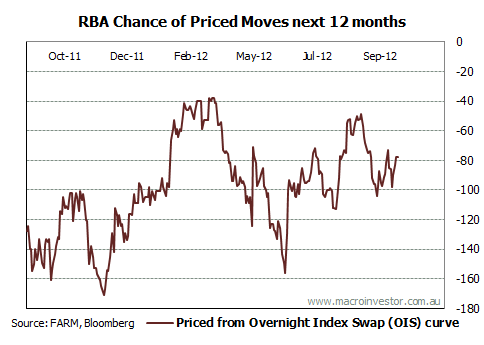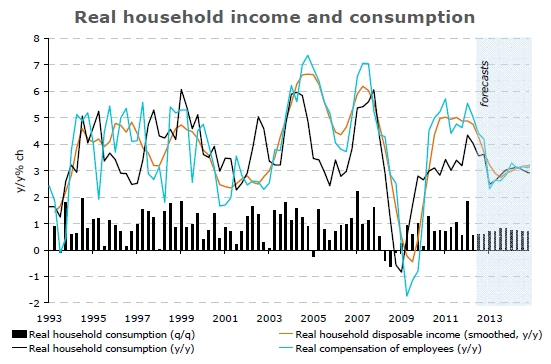Markets are leaning heavily towards a rate cut tomorrow. Three major banks are forecasting it and interest rate markets for the next twelve months see three cuts:

Bloomberg’s probability paths for rates show a straight line down to 2.5%:

The market probability of a cut for the next meeting is well above break even:

Here’s what the RBA said in the recent Minutes of the last meeting:
Since the last change to monetary policy in June, the Board had concluded that the stance of monetary policy resulting in interest rates being a bit below average was appropriate, given low inflation and the weaker outlook for growth globally. Developments since the previous Board meeting suggested that the global economy remained subject to significant downside risks. Of particular note this month was the recent sharp decline in some bulk commodity prices. At the same time, though, the domestic economy appeared to be growing at around trend pace and there were signs that the effects of earlier reductions in the cash rate were still working their way through the domestic economy.
The current assessment of the inflation outlook continued to provide scope to adjust policy in response to any significant deterioration in the outlook for growth. At this meeting, the Board judged that, with inflation expected to be consistent with the target and growth close to trend, but with a more subdued international outlook than was the case a few months ago, the stance of monetary policy remained appropriate.
I’ve highlighted the key sentence. Have we had a “significant deterioration in the outlook for growth” since the last meeting?
The data says no, we have not. Here’s what we’ve seen:
- second quarter GDP matched expectations and although it slowed was consistent with trend growth
- August unemployment was soft, down 8,800 jobs but the headline rate fell to 5.1%, saved by a falling participation rate. The trend remains sideways
- the PCI was weak by is pretty irrelevant these days
- the July trade deficit was worse than expected at $556 million and revision to previous months were also bad
- Lending Finance for July softened a touch
- The NAB Survey showed a good pick-up in current activity but a big slump in mining confidence
- Consumer confidence for September was more or less steady and has remained so on Roy Morgan’s weekly reading
- Car sales for August hit an all time high
- BREE downgraded its forecast commodity revenue by $20 billion
- Westpac’s Leading Index is going sideways
- DEEWR job vacancies came in stable for September after falling for seven months
- House prices firmed 1% or so in September
- Iron ore prices bounced from $86 to $100+
- The Aussie is up 2 cents over the month but has been as much as 4 cents higher so the terms of trade will have firmed in the month
There are hardly alarm bells ringing here.
The key words in the Minutes, however, are “outlook for growth”. On that score, the mass cancellation of BHP projects over the past month, the troubles of Fortescue and any number of other mining cut backs may be a trump card. Moreover, although Chinese data stabilised on the month, there is very little sense that it is about to accelerate.
There are also the accelerating job cuts in the public sector to consider.
The balance of these data points is that the outlook for growth has deteriorated, but not yet substantially. In fact, the evidence to date is that so long as mining doesn’t bust, there’s the beginning of a hand-off in growth to the old services states going on.
But the big issue is captured nicely by the following charts from the ANZ. First, there is an income shock coming from the bulk commodity falls:

And second, this is swiftly curtailing the much vaunted investment pipeline:

In my view, unless China recovers its appetite for fixed asset investment in the near future, then everything in the light blue and grey categories is at risk so the boom is also at risk of peaking earlier and tailing off more quickly than is generally appreciated.
My view then is that a prudent central bank (as one reader put it) should cut tomorrow. My guess is that it will wait until November.

